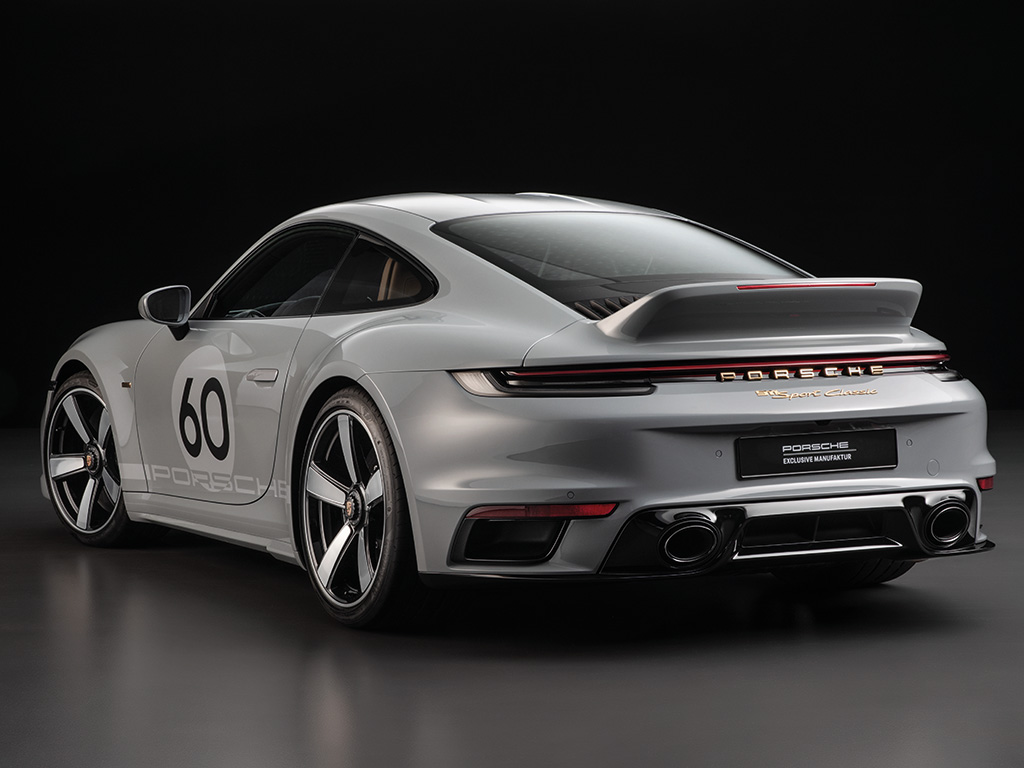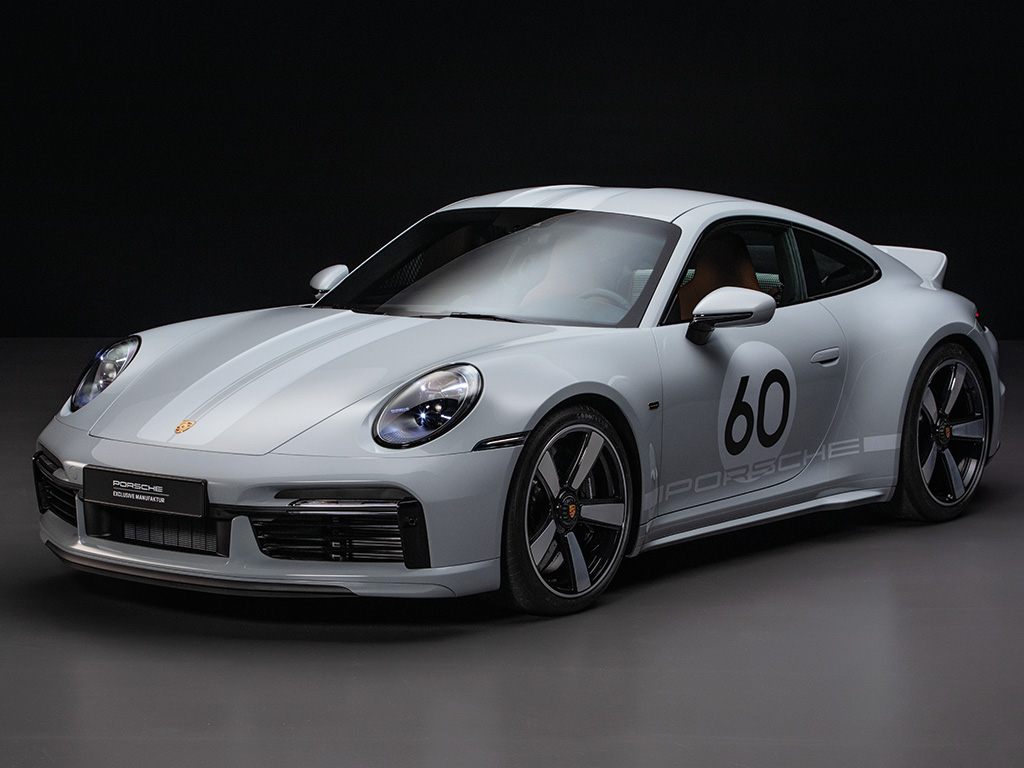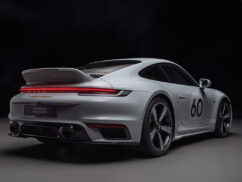Porsche unveils delectable new 911 Sport Classic
Porsche has dusted off its hallowed Sport Classic nameplate with a tasty retro-laced take on the current-gen (992 Series) 911, with just 1,250 units set to be crafted by Porsche’s Exclusive Manufaktur division that rolls out bespoke cars.
As per the previous model that wore the Sport Classic badge – a 2009 low-volume special based on the 997 generation – the newbie draws its stylistic inspiration from the original (1964-73) 911 and, in particular, the now-priceless 1972 911 Carrera RS 2.7.
Although utilising the same core powertrain as the latest 911 Turbo models, the Sport Classic’s mildly detuned 3.7-litre, twin-turbo flat-six engine transmits its 550hp output to the tarmac via the rear wheels only (both Turbo and Turbo S are AWD).

The Sport Classic also differs from the Turbo and Turbo S as it gets a seven-speed manual gearbox with short-throw shifter and auto-blip in lieu of the eight-speed PDK auto that’s the only choice in the latter two. This powertrain combo earns the Sport Classic the status of being the most powerful Porsche equipped with a manual ’box.
Order books for the limited-edition model are now open and European deliveries commence in July, with international markets following thereafter.
European pricing starts from 272,714 euros, making the Sport Classic costlier than even the significantly more powerful 911 Turbo S, although the former’s limited-edition status and unique spec will undoubtedly make it a better long-term investment.
As per the Turbo and Turbo S, the Sport Classic’s flat-six turbo motor features Variable turbine geometry (VTG) and wastegates to achieve its healthy power output.
However, unlike its Turbo and Turbo S siblings – which feature air intakes in the flanks – the Sport Classic feeds air to the engine bay via ducts under the rear spoiler. This makes for a cleaner look, as evidenced by the accompanying images.
Porsche says it has also tweaked the standard sports exhaust system to ensure the Sport Classic has a fruitier exhaust note, and it’s also removed some of the car’s interior insulation, so occupants get to fully experience the flat-six orchestra.
The Sport Classic’s suspension is based on that of the 911 Turbo and 911 GTS models and is equipped as standard with Porsche Active Suspension Management (PASM) adaptive dampers, which combine with the sports suspension to lower ride height by 10mm.
However, the fact that the 911 Sport Classic is rear-wheel drive means there’s less weight on the front axle than is the case in its all-wheel-driven siblings. To compensate for this, Porsche’s suspension engineers have slightly reduced the spring rate on the front axle.

The steering system, including the standard rear-axle steering, has also been modified especially for the 911 Sport Classic.
Stopping power promises to be up to the mark as the Sport Classic is fitted as standard with the Porsche Ceramic Composite Brake (PCCB) package as part of the vehicle’s generous spec level. The brake callipers are painted in High-Gloss Black and feature a white Porsche logo.
The Sport Classic is easy to distinguish as, apart from the fact that it ditches the side air inlets of the Turbo/Turbo S, it gets a double-dome roof and a recess profile on the bonnet, which ties in with the painted double stripes. In addition, the bonnet and roof are made of carbon-fibre-reinforced plastic (CFRP) to save weight.
There’s no mistaking the Sport Classic from the rear as its defining feature is a large, fixed spoiler made of CFRP that references the shape of the iconic ‘ducktail’ spoiler of the 911 RS 2.7 from 1972. The third brake light is integrated into the spoiler.
The 911 Sport Classic sits on 20- and 21-inch centre-lock wheels inspired by Fuchs rims of the 1960s and early ’70s. The faces of the wide spokes and the rim flange are polished, making them stand out against the black rim base and black sides of the spokes.

Meanwhile, the front fenders bear gold-coloured ‘Porsche Exclusive Manufaktur’ badges. These badges used to indicate the coachbuilder – such as Reutter or Karmann – whereas they now show that the vehicle was created by Porsche Exclusive Manufaktur.
The grille of the rear engine cover bears a ‘Porsche Heritage’ badge, the design of which is reminiscent of the Porsche 356 badge that was awarded in the 1950s when a vehicle reached the 100,000km mark. The new badge is a hallmark of all four Heritage Design vehicles – the 911 Targa 4S Heritage Design Edition was the first of these collector’s items to bear it.
As with the first 911 Sport Classic (type 997) launched in 2009, the newbie is painted in Sport Grey Metallic paint, but it’s also available in solid Black, Agate Grey Metallic or Gentian Blue Metallic, should the customer prefer one of these hues.
The Sport Classic’s double stripes are painted in light Sport Grey and all elements of the painting process are carried out by hand, from marking out the design to painting the stripes. Multiple coats and intermediate sanding operations provide the perfect transition across the various body parts.
The graphics on the flanks of the vehicle reference the brand’s connection with motorsport. These graphics are also in light Sports Grey and include a Porsche logo, a round starting number field (known as a lollipop outline) and a personalised black start number (0 to 99 is available as an option at no extra charge).
The start number or the entire foil trim can be removed for drivers who do not want the complete package.

The Sport Classic’s bespoke treatment carries through to the interior. Aluminium doorsill trims in Light Silver with illuminated ‘911 Sport Classic’ logos spell out its identity, as do the Heritage Design floor mats.
The seats are trimmed in two-tone, semi-aniline leather upholstery in Black/Classic Cognac, and the 911 Sport Classic is the first vehicle to feature this spec. According to Porsche, only a very thin layer of paint is applied to protect the leather, which allows its natural structure to remain visible and the soft feel to be maintained.
A highlight of the interior is the iconic pepita houndstooth pattern on the door panels and seat centres. The pepita houndstooth pattern comprises small squares connected by diagonal stripes. Pepita was available for the first time as an official option in a Porsche 911 in 1965.
The pattern made its first comeback in 2013 as part of the ‘50 years of the 911’ special model launch. The original pepita houndstooth pattern made another one-off appearance inside the one-millionth 911 – another highly bespoke vehicle.
The instrument cluster features two high-resolution seven-inch displays, but there’s a few nods to the past: for example, the analogue rev counter features a classic-style needle. White hands and scale markings provide maximum contrast.
A gold-coloured limited-edition badge with the personalised vehicle number is positioned on the trim panel above the glove compartment, referencing the exclusivity of the 911 Sport Classic. The cabin is rounded off by perforated Race-Tex fabric on the roof lining and on the A-, B- and C-pillars.
The attention to detail behind the Sport Classic is also showcased by the vehicle key, which is painted in the car’s exterior colour and comes in a leather case that’s the same colour as the interior, as is the leather vehicle document folder.










Comments are closed. Please send an email if you have any feedback.